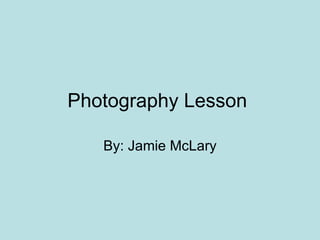Photography
- 1. Photography Lesson By: Jamie McLary
- 2. There are nine handles going across the monkey bars. Kyle goes all the way across the bars. Each bar is 11¬Ω inches. How far in inches did Kyle go on the monkey bars?
- 3. Hint: It is easier to use 11.5 inches when trying to find the answer. Also make sure you write the correct units.
- 4. Haley, Jenna, and Addy are in the same class at school. They have been friends since third grade. Haley is 54 inches tall. Jenna is 51 inches tall. Addy is 49¾ inches tall. How much taller is Haley then Addy? Haley Jenna Addy
- 5. Hint: Get rid of any extra information that you do not need. Haley Addy Jenna
- 6. Kate went to wal-mart to buy some fabric. She bought eight hundred forty-six centimeters of fabric. She wants to make four baby blankets for each of her sisters. How long will each of the baby blankets be?
- 7. Hint: Exclude extra information then put the numbers in number form instead of expanded form.
- 8. Grace and Sarah were practicing “Stop, Drop, and Roll” for fire safety. First they stopped, then they dropped, and then they each rolled. Grace rolled for 196 centimeters, and Sarah rolled for 188 centimeters. How far did they roll all together?
- 9. Hint: The question is asking how far ALL TOGETHER they traveled. ? = ?
- 10. Answers: 103.5 inches 4¼ inches 211½ centimeters 384 centimeters
- 11. GPS: M3N2. Students will further develop their skills of addition and subtraction and apply them in problem solving . a. Use the properties of addition and subtraction to compute and verify the results of computation . b. Use mental math and estimation strategies to add and subtract. c. Solve problems requiring addition and subtraction. d. Model addition and subtraction by counting back change using the fewest number of coins. M3N3. Students will further develop their understanding of multiplication of whole numbers and develop the ability to apply it in problem solving a. Describe the relationship between addition and multiplication, i.e. multiplication is defined as repeated addition. b. Know the multiplication facts with understanding and fluency to 10 x 10. c. Use arrays and area models to develop understanding of the distributive property and to determine partial products for multiplication of 2- or 3-digit numbers by a 1-digit number. d. Understand the effect on the product when multiplying by multiples of 10. e. Apply the identity, commutative, and associative properties of multiplication and verify the results f. Use mental math and estimation strategies to multiply. g. Solve problems requiring multiplication. M3N4. Students will understand the meaning of division and develop the ability to apply it in problem solving. a. Understand the relationship between division and multiplication and between division and subtraction. b. Recognize that division may be two situations: the first is determining how many equal parts of a given size or amount may be taken away from the whole as in repeated subtraction, and the second is determining the size of the parts when the whole is separated into a given number of equal parts as in a sharing model. c. Recognize problem-solving situations in which division may be applied and write corresponding mathematical expressions. d. Explain the meaning of a remainder in division in different circumstances. e. Divide a 2 and 3-digit number by a 1-digit divisor. f. Solve problems requiring division. g. Use mental math strategies to divide.
- 12. GPS continued… M3P1. Students will solve problems (using appropriate technology). a. Build new mathematical knowledge through problem solving. b. Solve problems that arise in mathematics and in other contexts. c. Apply and adapt a variety of appropriate strategies to solve problems. d. Monitor and reflect on the process of mathematical problem solving.











